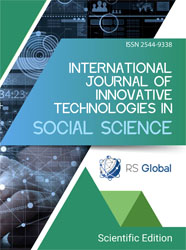THE IMPACT OF PHYSICAL ACTIVITY ON THE GUT MICROBIOME AND CLINICAL COURSE OF INFLAMMATORY BOWEL DISEASE
Abstract
Inflammatory bowel diseases (IBD), including ulcerative colitis and Crohn’s disease, are chronic disorders of complex and not yet fully understood etiology, involving genetic, immunological, and environmental factors. Increasing attention has been directed toward the role of the gut microbiome, whose disturbances play a significant role in the pathogenesis of these diseases. Concurrently, growing interest has been directed toward therapeutic strategies that support pharmacological treatment, including non-pharmacological interventions capable of modulating disease activity.
Physical activity is recognized as one of the key determinants of overall health, and its role in inflammatory bowel diseases is of particular importance. Regular and moderate exercise promotes the maintenance of intestinal barrier function, exerts a beneficial effect on the composition and diversity of the gut microbiota, reduces inflammatory processes, and supports patients’ mental well-being. These effects may contribute to longer remission periods, improved treatment tolerance, and enhanced quality of life.
Conversely, intensive and prolonged physical activity may act as a burden, potentially leading to destabilization of the intestinal barrier and exacerbation of disease symptoms. Therefore, proper adjustment of the type and intensity of physical activity represents an important component of supportive management.
The aim of this paper is to present the current state of knowledge regarding the impact of physical activity on the gut microbiome, immune system function, and the clinical course of inflammatory bowel diseases, as well as to discuss its potential role in the prevention of extraintestinal complications and in the comprehensive improvement of patients’ quality of life.
References
Ng SC, Shi HY, Hamidi N, et al. Worldwide incidence and prevalence of inflammatory bowel disease in the 21st century. Lancet. 2017;390(10114):2769–78. doi:10.1016/S0140-6736(17)32448-0
Khalili H, Ananthakrishnan AN, Konijeti GG, et al. Physical activity and risk of inflammatory bowel disease: prospective study from the Nurses’ Health Study cohorts. BMJ. 2013;347:f6633. doi:10.1136/bmj.f6633
Ordás I, Eckmann L, Talamini M, Baumgart DC, Sandborn WJ. Ulcerative colitis. Lancet. 2012;380(9853):1606–19. doi:10.1016/S0140-6736(12)60150-0
Kaplan GG, Ng SC. Globalisation of inflammatory bowel disease: perspectives from the evolution of inflammatory bowel disease in the UK and China. Lancet Gastroenterol Hepatol. 2016;1(4):307–16. doi:10.1016/S2468-1253(16)30077-2
Ananthakrishnan AN. Environmental risk factors for inflammatory bowel diseases: a review. Dig Dis Sci. 2015;60(2):290–98. doi:10.1007/s10620-014-3350-9
Huttenhower C, Gevers D, Knight R, et al. Structure, function and diversity of the healthy human microbiome. Nature. 2012;486(7402):207–14. doi:10.1038/nature11234
Nishida A, Inoue R, Inatomi O, et al. Gut microbiota in the pathogenesis of inflammatory bowel disease. Clin J Gastroenterol. 2018;11(1):1–10. doi:10.1007/s12328-017-0816-5
Clarke SF, Murphy EF, O’Sullivan O, et al. Exercise and associated dietary extremes impact on gut microbial diversity. Gut. 2014;63(12):1913–20. doi:10.1136/gutjnl-2013-306541
Mailing LJ, Allen JM, Buford TW, Fields CJ, Woods JA. Exercise and the gut microbiome: a review of the evidence, potential mechanisms, and implications for human health. Exerc Sport Sci Rev. 2019;47(2):75–85. doi:10.1249/JES.0000000000000183
Mach N, Fuster-Botella D. Endurance exercise and gut microbiota: a review. J Sport Health Sci. 2017;6(2):179–97. doi:10.1016/j.jshs.2016.05.001
Codella R, Luzi L, Terruzzi I. Exercise has the guts: how physical activity may positively modulate gut microbiota in chronic and immune-based diseases. Dig Liver Dis. 2018;50(4):331–41. doi:10.1016/j.dld.2017.11.016
Allen JM, Mailing LJ, Niemiro GM, et al. Exercise alters gut microbiota composition and function in lean and obese humans. Med Sci Sports Exerc. 2018;50(4):747–57. doi:10.1249/MSS.0000000000001495
Petersen LM, Bautista EJ, Nguyen H, et al. Community characteristics of the gut microbiomes of competitive cyclists. Microbiome. 2017;5(1):98. doi:10.1186/s40168-017-0320-4
World Health Organization. Global recommendations on physical activity for health. Geneva: WHO; 2010. DOI: N/A
Nieman DC, Wentz LM. The compelling link between physical activity and the body’s defense system. J Sport Health Sci. 2019;8(3):201–17. doi:10.1016/j.jshs.2018.09.009
Ni J, Wu GD, Albenberg L, Tomov VT. Gut microbiota and IBD: causation or correlation? Nat Rev Gastroenterol Hepatol. 2017;14(10):573–84. doi:10.1038/nrgastro.2017.88
Chan SS, Luben R, Olsen A, et al. Physical activity and risk of inflammatory bowel disease: prospective study in the EPIC cohort. BMJ Open Gastroenterol. 2014;1(1):e000026. doi:10.1136/bmjgast-2014-000026
Klare P, Nigg J, Nold J, et al. The impact of a ten-week physical exercise program on health-related quality of life in patients with inflammatory bowel disease. PLoS One. 2015;10(3):e0122077. doi:10.1371/journal.pone.0122077
Cook MD, Allen JM, Pence BD, et al. Exercise and gut immune function: evidence of alterations in colon immune cell homeostasis and microbiome characteristics with exercise training. Gut Microbes. 2016;7(6):574–89. doi:10.1080/19490976.2016.1240827
Neurath MF. Cytokines in inflammatory bowel disease. Nat Rev Immunol. 2014;14(5):329–42. doi:10.1038/nri3661
Gleeson M, Bishop NC, Stensel DJ, et al. The anti-inflammatory effects of exercise: mechanisms and implications for the prevention and treatment of disease. Nat Rev Immunol. 2011;11(9):607–15. doi:10.1038/nri3041
Walsh NP, Gleeson M, Shephard RJ, et al. Position statement – immune function and exercise. Exerc Immunol Rev. 2011;17:6–63.
Bilski J, Mazur-Bialy A, Brzozowski B, et al. Moderate exercise training attenuates the severity of experimental rodent colitis: the importance of crosstalk between adipose tissue and skeletal muscles. Mediators Inflamm. 2015;2015:605071. doi:10.1155/2015/605071
Lambert GP. Stress-induced gastrointestinal barrier dysfunction and its inflammatory effects. J Anim Sci. 2009;87(Suppl 14):E101–8. doi:10.2527/jas.2008-1339
Engels M, Cross RK, Long MD. Exercise in patients with inflammatory bowel diseases: current perspectives. Clin Exp Gastroenterol. 2017;10:265–74. doi:10.2147/CEG.S135578
Parada Venegas D, De la Fuente MK, Landskron G, et al. SCFAs-mediated gut epithelial and immune regulation... Front Immunol. 2019;10:277. doi:10.3389/fimmu.2019.00277
Kelly CJ, Zheng L, Campbell EL, et al. Crosstalk between microbiota-derived SCFAs and intestinal epithelial HIF augments tissue barrier function. Cell Host Microbe. 2015;17(5):662–71. doi:10.1016/j.chom.2015.03.005
Palmela C, Chevarin C, Xu Z, et al. Adherent-invasive Escherichia coli in inflammatory bowel disease. Gut. 2018;67(3):574–87. doi:10.1136/gutjnl-2017-314903
March DS, Marchbank T, Playford RJ, et al. Intestinal fatty acid-binding protein and gut permeability responses to exercise. Eur J Appl Physiol. 2017;117(5):931–41. doi:10.1007/s00421-017-3572-0
Yang Y, Jobin C. Microbial imbalance and intestinal pathologies: connections and contributions. Dis Model Mech. 2014;7(10):1131–42. doi:10.1242/dmm.016766
Loudon CP, Carroll V, Butcher J, Rawsthorne P, Bernstein CN. Effects of physical activity on health and disease outcomes in IBD: a review. Am J Gastroenterol. 2014;109(6):920–9. doi:10.1038/ajg.2013.452
Jones PD, Kappelman MD, Martin CF, et al. Exercise and self-reported limitations in adults with Crohn’s disease and ulcerative colitis. Inflamm Bowel Dis. 2015;21(3):439–46. doi:10.1097/MIB.0000000000000295
Graff LA, Walker JR, Bernstein CN. Depression and anxiety in IBD: a review of comorbidity and management. Inflamm Bowel Dis. 2009;15(7):1105–18. doi:10.1002/ibd.20873
Costa RJS, Snipe RMJ, Kitic CM, Gibson PR. Systematic review: exercise-induced gastrointestinal syndrome—implications for health and intestinal disease. Aliment Pharmacol Ther. 2017;46(3):246–65. doi:10.1111/apt.14174
Marchbank T, Davison G, Oakes JR, et al. Bovine colostrum truncates the increase in gut permeability caused by heavy exercise in athletes. Am J Physiol Gastrointest Liver Physiol. 2011;300(3):G477–84. doi:10.1152/ajpgi.00439.2010
van Wijck K, Lenaerts K, Grootjans J, et al. Physiology and pathophysiology of splanchnic hypoperfusion and intestinal injury during exercise. Am J Physiol Gastrointest Liver Physiol. 2012;303(2):G155–68. doi:10.1152/ajpgi.00157.2012
Pals KL, Chang RT, Ryan AJ, Gisolfi CV. Effect of running intensity on intestinal permeability. J Appl Physiol. 1997;82(2):571–6. doi:10.1152/jappl.1997.82.2.571
Dokladny K, Moseley PL, Ma TY. Physiologically relevant increase in temperature causes an increase in intestinal epithelial tight junction permeability. Am J Physiol Gastrointest Liver Physiol. 2006;290(2):G204–12. doi:10.1152/ajpgi.00401.2005
Peters HP, de Vries WR, van Berge Henegouwen GP, et al. Potential benefits and hazards of physical activity and exercise on the gastrointestinal tract. Gut. 2001;48(3):435–9. doi:10.1136/gut.48.3.435
ter Steege RWF, Kolkman JJ. Pathophysiology and management of gastrointestinal symptoms during physical exercise, and role of splanchnic blood flow. Aliment Pharmacol Ther. 2012;35(5):516–28. doi:10.1111/j.1365-2036.2011.04980.x
Vavricka SR, Rogler G, Gantenbein C, et al. Chronological order of appearance of extraintestinal manifestations relative to the time of IBD diagnosis. Inflamm Bowel Dis. 2015;21(8):1794–800. doi:10.1097/MIB.0000000000000392
Ott C, Takses A, Obermeier F, et al. The incidence of extraintestinal manifestations in IBD: a prospective study. Digestion. 2014;90(4):227–32. doi:10.1159/000367632
Compston JE. Osteoporosis in IBD. Gut. 2003;52(1):63–4. doi:10.1136/gut.52.1.63
Marques EA, Mota J, Carvalho J. Exercise effects on bone mineral density in older adults: a meta-analysis of randomized controlled trials. Age (Dordr). 2012;34(6):1493–1515. doi:10.1007/s11357-011-9383-7
Robinson RJ, al-Azzawi F, Iqbal SJ, et al. Osteoporosis and determinants of bone density in patients with Crohn’s disease. Gut. 1998;42(6):791–6. doi:10.1136/gut.42.6.791
Bryant RV, Trott MJ, Bartholomeusz FD, Andrews JM. Body composition in adults with IBD. Aliment Pharmacol Ther. 2013;38(3):213–25. doi:10.1111/apt.12372
Taguchi T, Kishikawa H, Takahashi H, et al. Effect of resistance exercise training on muscle strength and mass in patients with IBD. Eur J Gastroenterol Hepatol. 2020;32(3):319–25. doi:10.1097/MEG.0000000000001676
Pedersen BK, Saltin B. Exercise as medicine – evidence for prescribing exercise as therapy in 26 different chronic diseases. Scand J Med Sci Sports. 2015;25 Suppl 3:1–72. doi:10.1111/sms.12581
Zanoli L, Cannavò M, Rastelli S, et al. Arterial stiffness in inflammatory bowel disease: a systematic review and meta-analysis. J Hypertens. 2016;34(5):822–29. doi:10.1097/HJH.0000000000000840
Views:
61
Downloads:
15
Copyright (c) 2025 Katarzyna Adrianna Tryniecka, Diana Wisz, Filip Maciej Huzarski, Katarzyna Maria Turek, Weronika Worosz, Alicja Zań

This work is licensed under a Creative Commons Attribution 4.0 International License.
All articles are published in open-access and licensed under a Creative Commons Attribution 4.0 International License (CC BY 4.0). Hence, authors retain copyright to the content of the articles.
CC BY 4.0 License allows content to be copied, adapted, displayed, distributed, re-published or otherwise re-used for any purpose including for adaptation and commercial use provided the content is attributed.















